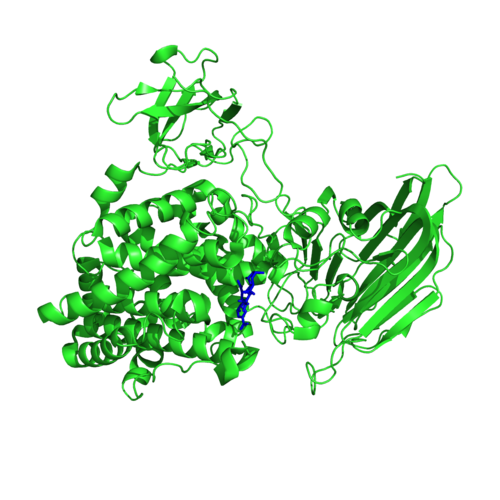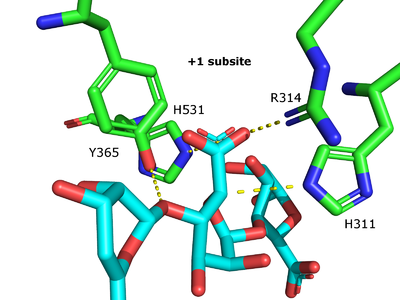CAZypedia needs your help! We have many unassigned GH, PL, CE, AA, GT, and CBM pages in need of Authors and Responsible Curators.
Scientists at all career stages, including students, are welcome to contribute to CAZypedia. Read more here, and in the 10th anniversary article in Glycobiology.
New to the CAZy classification? Read this first.
*
Consider attending the 15th Carbohydrate Bioengineering Meeting in Ghent, 5-8 May 2024.
Polysaccharide Lyase Family 15
This page is currently under construction. This means that the Responsible Curator has deemed that the page's content is not quite up to CAZypedia's standards for full public consumption. All information should be considered to be under revision and may be subject to major changes.
- Author: ^^^Emil Stender^^^
- Responsible Curator: ^^^Birte Svensson^^^
| Polysaccharide Lyase Family 15 | |
| 3D structure | (α/α)6 barrel + anti-parallel β-sheet |
| Mechanism | β-elimination |
| Charge neutralizer | Arginine and histidine |
| Active site residues | known |
| CAZy DB link | |
| http://www.cazy.org/PL15.html | |
Substrate specificities
PL15 contains 2 subfamilies [1] as well as several proteins not assigned to any subfamily. Subfamily 1 has been shown to only degrade alginate [2, 3, 4, 5] while subfamily 2 has been found to be heparin and heparan sulfate lyases [6, 7]. Alginate consisting of 1,4 linked β-D-mannuronic acid and α-L-guluronic acid arranged in poly-mannuronic acid blocks, poly-guluronic acid blocks or poly-mannuronic/guluronic acid blocks [8, 9]. Heparin consisting of disaccharide repeating units of which the most common is 2-O-sulfated 1,4 linked α-L-iduronic acid and 6-O-sulfated, N-sulfated glucosamine [IdoA(2S)-GlcNS(6S)]. Heparan sulfate being very similar to heparin having the IdoA replaced with β-D-glucuronic acid with a considerably more variable sulfation and acetylation pattern [10].
Kinetics and Mechanism
The β-elimination catalyzed by the PL15 enzymes results in the formation of a C4-C5 unsaturated sugar at the new non-reducing end. The first step is the neutralization of the acid group in the +1 subsite by the conserved H531 and R314 (Atu3025 numbering)[3]. This lowers the pKa value of the C5-proton allowing for abstraction by the catalytic base (Figure 1). A catalytic acid then donates a proton to the glycosidic linkage resulting in the β-elimination.
Catalytic Residues
After charge neutralization a histidine functions as the catalytic base and a tyrosine the acid. They were originally identified as H311 and Y365 in Atu3025 from Agrobacterium fabrum [3].
Three-dimensional structures

The first crystal structure available for a PL15 memberwas that of the alginate lyase Atu3025 from Agrobacterium fabrum (Figure 2) [3]. The catalytic domains consists of an N-terminal (α/α)6 barrel domain and a C-terminal anti-parallel β-sheet domain. The catalytic site is located between the two domains with the catalytic residues and the arginine charge neutralizer located in the (α/α)6 barrel and the histidine neutralizer in a loop extending into the active site from the anti-parallel β-sheet domain [3].
Family Firsts
- First catalytic activity
- Alginate lyase IV from Sphingomonas sp activity shown against alginate di- and trisaccharides by TLC from purified protein [2].
- First catalytic base/acid
- Atu3025 from Agrobacterium fabrum. H311 and Y365 was suggested as Acid/base based upon the crystal structure of the substrate complex, residue conservation, mutagenesis and activity analysis (H311A: inactive and Y365A: 0.3 % activity remaining)[3].
- First charge neutralizer
- Atu3025 from Agrobacterium fabrum H531 was suggested based on the crystal structure, its conservation, mutagenesis and activity analysis (H531A 0.45 % activity). R314 is proposed based on its proximity to the carboxylate group in the +1 subsite and its conservation [3].
- First 3-D structure
- Atu3025 from Agrobacterium fabrum an exo alginate lyase from subfamily 1 [3].
References
- Lombard V, Bernard T, Rancurel C, Brumer H, Coutinho PM, and Henrissat B. (2010). A hierarchical classification of polysaccharide lyases for glycogenomics. Biochem J. 2010;432(3):437-44. DOI:10.1042/BJ20101185 |
- Miyake O, Hashimoto W, and Murata K. (2003). An exotype alginate lyase in Sphingomonas sp. A1: overexpression in Escherichia coli, purification, and characterization of alginate lyase IV (A1-IV). Protein Expr Purif. 2003;29(1):33-41. DOI:10.1016/s1046-5928(03)00018-4 |
- Ochiai A, Yamasaki M, Mikami B, Hashimoto W, and Murata K. (2010). Crystal structure of exotype alginate lyase Atu3025 from Agrobacterium tumefaciens. J Biol Chem. 2010;285(32):24519-28. DOI:10.1074/jbc.M110.125450 |
- Jagtap SS, Hehemann JH, Polz MF, Lee JK, and Zhao H. (2014). Comparative biochemical characterization of three exolytic oligoalginate lyases from Vibrio splendidus reveals complementary substrate scope, temperature, and pH adaptations. Appl Environ Microbiol. 2014;80(14):4207-14. DOI:10.1128/AEM.01285-14 |
- Hashimoto W, Miyake O, Ochiai A, and Murata K. (2005). Molecular identification of Sphingomonas sp. A1 alginate lyase (A1-IV') as a member of novel polysaccharide lyase family 15 and implications in alginate lyase evolution. J Biosci Bioeng. 2005;99(1):48-54. DOI:10.1263/jbb.99.48 |
- Cartmell A, Lowe EC, Baslé A, Firbank SJ, Ndeh DA, Murray H, Terrapon N, Lombard V, Henrissat B, Turnbull JE, Czjzek M, Gilbert HJ, and Bolam DN. (2017). How members of the human gut microbiota overcome the sulfation problem posed by glycosaminoglycans. Proc Natl Acad Sci U S A. 2017;114(27):7037-7042. DOI:10.1073/pnas.1704367114 |
- Helbert W, Poulet L, Drouillard S, Mathieu S, Loiodice M, Couturier M, Lombard V, Terrapon N, Turchetto J, Vincentelli R, and Henrissat B. (2019). Discovery of novel carbohydrate-active enzymes through the rational exploration of the protein sequences space. Proc Natl Acad Sci U S A. 2019;116(13):6063-6068. DOI:10.1073/pnas.1815791116 |
-
Haug, A., Larsen, B., and Smidsrod, O. (1967) Studies on sequence of uronic acid residues in alginic acid. Acta Chem. Scand. 21, 691–704. DOI:10.3891/acta.chem.scand.21-0691
-
Haug, A., Larsen, B., and Smidsrod, O. (1966) A study of constitution of alginic acid by partial acid hydrolysis. Acta Chem. Scand. 20, 183–190. DOI:10.3891/acta.chem.scand.20-0183
- Garron ML and Cygler M. (2010). Structural and mechanistic classification of uronic acid-containing polysaccharide lyases. Glycobiology. 2010;20(12):1547-73. DOI:10.1093/glycob/cwq122 |
